When I take newbies shooting for the very first time, the number one thing that they’re concerned about isn’t noise or the high velocity piece of hot lead rocketing out the end of the firearm — it’s recoil. They’re concerned that the gun will push them backwards or knock them down…and it will hurt.
That’s not an entirely unfounded concern, but with typical, widely used firearm cartridges and the guns that fire them, the chance that you’ll actually be thrown off balance or injured by recoil is between slim to none. Especially with some good, basic instruction.
Even so, recoil can slow down your follow-up shots and still be somewhat uncomfortable, especially over a long range session. For those looking to reduce or virtually eliminate recoil, here are my top three recommendations.
1. Shoot a Lighter Projectile
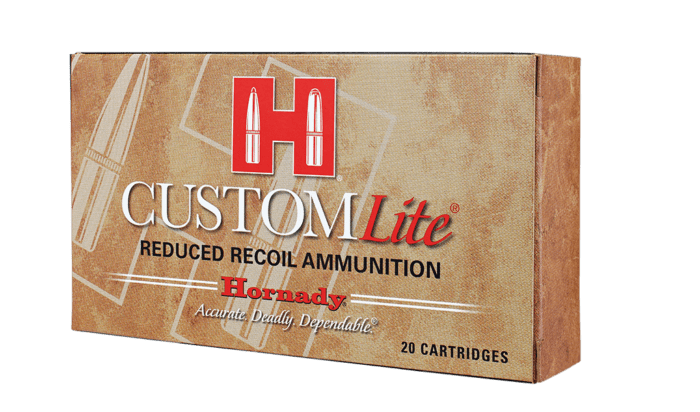
Recoil is nothing more than Newton’s third law in action. You’re throwing a (relatively) heavy piece of lead very quickly downrange, and however much force that requires will be translated straight back through the gun into your shoulder.
The simplest and easiest way to lighten that equal and opposite reaction is to lighten your projectiles (or shoot them with a heavier gun). Heavier bullets need more force to be propelled downrange. Using a lighter round will require less force, and therefore you’ll feel less recoil as a result.
Some firearms won’t function well shooting lighter projectiles. A semiautomatic AR-15 rifle, for example, needs a certain amount of back pressure in the barrel to pressurize the gas system and cycle the action. Lighter projectiles with less force are in the barrel for a shorter period of time, so there isn’t as much pressure available to operate the action.
Your mileage may vary. Experiment with different projectile weights in your gun(s) and see which works best for you.
If using a lighter load doesn’t work, consider shooting lighter calibers. There’s a reason I start all my new shooters on a .22LR rifle and not a .50AE handgun.
2. Invest in a Good Muzzle Brake or Suppressor
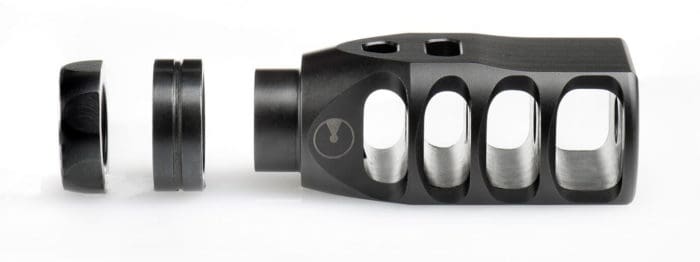
If a lighter projectile isn’t your thing, you can make Sir Isaac Newton work for you. There are a lot of gasses that escape form the end of your barrel with every shot. Mostly, those gasses are vented into the atmosphere without doing anything else useful. You can put those lazy-ass gasses to good use.
The idea behind using a muzzle brake is, rather than just venting those gasses, you can harness their energy. The brake works by using the forward motion of those gasses to actually pull the firearm forward slightly, canceling out some of the recoil impulse generated by the force of the projectile leaving the barrel.
You’ll never get 100% recoil mitigation, but a brake will definitely help.
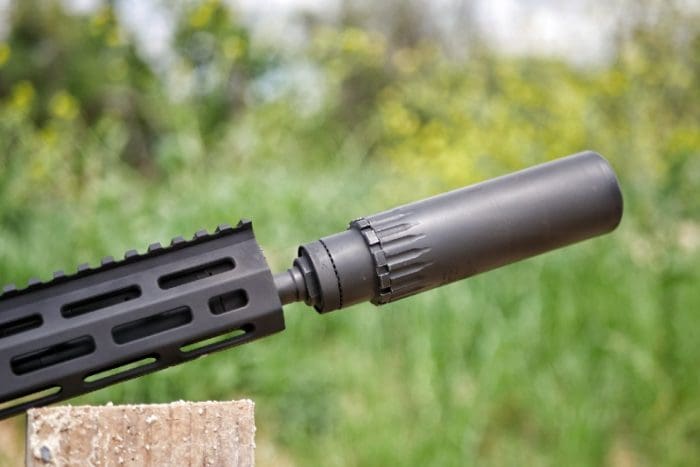
Another form of muzzle brake that has the same kind of effect is a silencer. A quieter, softer-recoiling rifle means a huge improvement for just about any shooter. If you’re looking to make your gun both quieter and far more comfortable to shoot, a silencer checks way more than just one box at a time.
3. Improve Your Stance
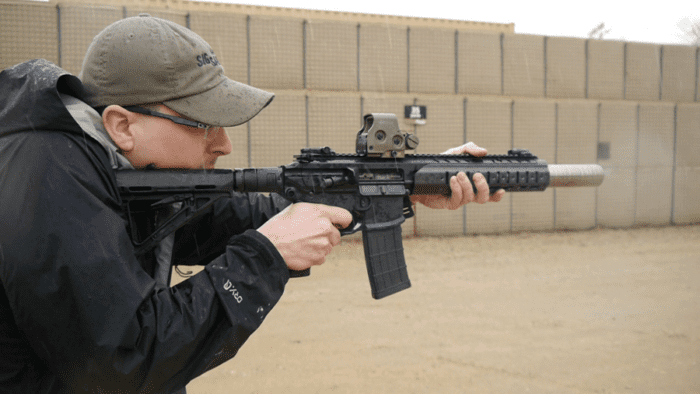
It’s not the gun, it’s you.
Using the proper stance can make an amazing amount of difference in felt recoil. Ideally, recoil should be directed straight back into your shoulder where it can be absorbed throughout your body, all the way down to your feet.
Having a slightly forward stance with the gun tucked firmly into your shoulder with a solid grip on a properly-fitted firearm will do far more to mitigate the impact of recoil than any muzzle device. And combining a proper stance with a muzzle brake or suppressor results in a firearm that stays steady as a rock even through full-auto fire.
Experiment with a variety of guns and calibers if you can. Get some quality training and practice good form and you too will be able to handle recoil like a boss.

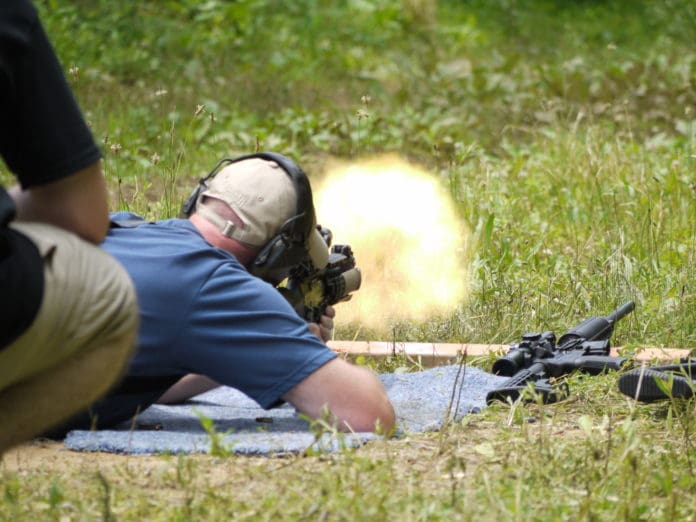



Eliminate? Don’t think so.
“reduce or virtually eliminate”
I really abhor muzzle brakes on all but heavy magnums on lightweight guns, which I also abhor.
Here are the four ways I would recommend.
1. Learn what proper body alignment is and fight to achieve that alignment with every shot.
2. Get a heavier firearm.
3. Get a proper fitting grip or stock.
4. Silence the firearm. A lot of perceived recoil is muzzle blast. The silencer also adds weight.
Don’t shoot a heavier cartridge than needed. For example while .300 win mag is great for lange range elk hunting. It isn’t needed for short range deer hunting. A .243 or 30-30 will work fine. 😉
Silencers are not legal here, so back to the obnoxious heavy muzzle break.
JWT That is exactly what I was thinking as I read the article.
Basic physics.
Conservation of momentum and energy applies.
Mass of projectile multiplied by velocity of projectile equals EFFECTIVE mass of firearm multiplied by recoil velocity of firearm.
Recoil energy equals one half the mass of the firearm multiplied by the recoil vehicle squared.
RE = 1/2*M*V^2
V = m*v/M
Therefore:
RE = 1/2*M*(m*v/M)^2
RE = a constant / effective mass of the firearm.
The best and easiest way to reduce felt recoil or recoil energy is to increase the effective mass of the firearm. Heavier guns have lower recoil for a given caliber. You can make the gun effectively heavier by pulling the stock tight against your shoulder and leaning into it.
Mr Leghorn (any relation to Leghorn Foghorn) mentions this. I just explained the physics of why it works.
.22 rifle is the easiest for a novice to shoot but an AR-15 rodent rifle is about as easy.
I’ve noticed ear muffs take a lot of the recoil out. Put a couple pair of ear muffs on the shoulder pad, hang a couple dozen from the barrel, tames it right down
Not too close to the muzzle though, or you’ll need a Form 1.
Actually ear pro does seem to take a lot of the recoil out. I know that’s physically impossible, but shoot a gunm without it and they do seem to kick harder.
With the .22LR caliber there is also a considerable variety of powder charges and velocity levels. I once saw a father or maybe grandfather getting a six year old boy started on a Ruger 10/22.
The rifle wasn’t cycling reliably and when I looked at their setup, they had chosen to shoot CCI Quiet-22, 40gr ammo with a 710 fps velocity. Now that’s a low recoil round. I suggested that they get some standard velocity ammo. I see that CCI now also sells a Quiet-22 Semi-Auto that has a little more oomf.
I shot many a squirrel off my bird feeder with CCI quiets out of a lever action (like you said, didn’t cycle with a 10/22). Recoil and noise were barely more than a BB gun. The neighbors never noticed.
I was amazed at how little (felt) recoil there was when shooting my 300 Win Mag prone for a day at the Sinclair Full Bore some years ago.
Vltor A5 buffer system is good way to reduce felt recoil too.
.50 BMG is amazingly light recoil.
Easiest way to reduce felt recoil? Don’t pull the trigger.
/snark
Shoot a bazooka.
They were originally called recoilless rifles. 🙂
Not quite.
A bozoka is technically a rocket launcher. There is no recoil.
A recoilless rifle is technically a light artillery piece, but with a rocket nozzle at the breach. The thrust from the rocket balances the momentum of the projectile.
A recoilless rifle consumes less propellant for a given projectile mass and velocity than a rocket but more than a conventional gun.
I have on occasion demonstrated the minimal recoil from an AR-15 rodent rifle by putting the stock to my groin and firing a full, 30 round magazine while singing the STAR SPANGLED BANNER in basso profoundo without missing a beat. I then invite my politically correct, hopliphobic guest to try this trick with a 12 gauge shotgun. They invariably end up singing soprano for the rest of their lives.
Lol, I just had a mental image of that.
Don’t forget the ol’ “push-pull” fore end grip. Once I mastered that, I no longer dreaded magnum 12 gauge shells.
Try using a sling. It helps support the gun and makes it easier to control. Better control helps with recoil management.
Start with .22LR and .223 Remington. The recoil pulse is about the same, even though the latter has a heavier bullet and 3x the velocity.
weird; my 147gr rounds at 130 pf have way less recoil than my 115gr rounds at 130 pf.
Maybe because it’s physics?
A 147gr projectile at 885 fps generates 256 ft-lbs of energy.
A 115gr projectile at 1130 fps generates 326 ft-lbs of energy.
That energy is recoil felt by the shooter.
Which is why us competitive shooters have known for a very long time that, given a set power factor, the heavier projectile generates less recoil.
busybeef,
Kinetic energy of the bullet is important especially in creating more damage in a wound channel. But felt recoil is about momentum. The amount of momentum imparted to the firearm is equal and oppositely directed, compared to the bullet.
In your example the heavy bullet has almost exactly the same momentum as the lighter bullet. It might be true that the burnt powder gases come out of the barrel a little hotter and faster with the light bullet, and there is some recoil generated from the escaping gases.
With Winchester White Box 9mm ammo, the 147gr bullet leaves the muzzle with about 6.3% more momentum than the 115gr bullet.
With Federal Amer. Eagle 9mm, the 147gr bullet has 10% more momentum than the 115gr bullet.
I imagine that the gas jetting from the muzzle is a bigger recoil effect with a 3″ barrel than for a 5″ barrel. No idea how big those effects are.
Really it’s mostly blast. I light weight 270 in a crappy stock is going to hurt but flinching is from the blast. The answer is a supressor.
Or intentional practice. I found for a while that I was consistently missing easy pistol shots, and spent time on a bench diagnosing my problem. Turned out I had developed a bad anticipation habit without realizing it. After that, I made sure to spend lots of time mixing snap caps in with live ammo at the range until I had banished the habit. Now I can tell when I’m working up to badly anticipate a shot, stop, take a breath, and be better. Caliber, etc. aren’t the issue. My own psychology is.
When you anticipate the recoil, you “brace for impact” by tensing up your shoulder muscles, which counterintuitively will make the kick harder, because you’re resisting the recoil instead of riding it. Like the “rope a dope” in boxing, where a fighter on the defensive lets the ropes support him instead of standing rigid, lessening the impact of the opponent’s punches.
“Let the trigger surprise you.”, as my brother puts it.
No. 4 Buy a Limbsaver slip on buttpad. Tames those short stocked milsurp bolt actions right down.
I have taken approximately 1 million new shooters to the range.
1. When at all possible start with a .22 rifle and this isn’t a concern.
2. Don’t let their first centerfire rifle shots be off a bench or prone. Have them shoot off hand, leaning with center-of-gravity in front of their belly button. Less felt recoil because of physics/mechanics reasons.
3. Don’t let them shoot compensated centerfire underneath an awning, next to a wall, or indoors. The concussion wave reflecting under the awning, wall, or roof freaks out new shooters and they always seem to mistake their shocked reflexes and headaches for “recoil effects”, and then generally have a “bad experience”.
4. Before you let them shoot, you shoot with them standing right behind you. Then they know what to expect and aren’t surprised by the “excitement”.
5. Put new right handed shooters at the leftmost position on the line, and stand off their right shoulder. Most f*k-ups point left for right handed shooters. Do opposite for left handed shooters.
I always started my kids off with the M1 carbine.
As each one got to be age 12 I will take them to the range and let him shoot the M1 carbine off a rest.
It is really the softest shooting gun besides a 22.
I know this is an alien concept for the youths who think that AR-style stocks are the be-all, end-all of rifle stocks in this world, but I would offer this:
If you get a gun that fits you, and allows you to mount the gun to your shoulder and your cheek properly, it goes a long way towards managing recoil and allowing you to shoot more with less fatigue. Well-fit gunstocks also help you put rounds on target quickly, and make moving shots much more easily.
The simple fact of most AR stocks is that they suck. The ergonomics of the AR are great as far as the controls go, but utterly horrible where gun fit and stock weld are concerned. Fortunately, the AR has little recoil at all.
An option rarely examined by shooters for reducing recoil in long arms is to insert a mercury capsule into the buttstock. This won’t reduce the overall momentum, but it will spread out the recoil impulse.
If it hurts, don’t do that.
Best I’ve found is simply keep the stock firmly planted in the correct part of your shoulder.
For pistols firm grip, elbows slightly bent, etc.
No gadgets or accessories required. For most (within reason) it’s as much or more psychological as it is physical.
As anyone who’s hunted knows, once that pheasant flushes or those ducks fly in or that deer/elk/bear/whatever appears recoil suddenly and magically disappears.
Anyone in a defensive shoot same thing, they’ll tell you they never felt the recoil.
So was the physical force of recoil ever a problem to begin with? The answer is no. It’s the same gun shooting the same stuff, the only thing that changed is the shooters priorities and mindset.
I find recoil bothersome when shooting targets, because they’re targets, not dinner or an attacker or something.
It’s mostly mental within reason.
Without reason would be handing grandma, or a kid, or a beginner of any age, a 12guage full of 3-1/2″ goose loads, or a .44mag, or anything north of 30-06, etc. Especially first timers. You just gonna turn them off to the whole gun thing, or develop some bad habits if they do choose to suffer through.
The guy upthread had it right. Rifle or pistol start with a .22 and work up from there. In shotguns a .410 has pretty much no recoil but you also have to be good to hit anything that’s moving with one. There a 20 guage where the gun is heavy and the loads are light can be a better choice. Chances of successful hits are greater, which breeds confidence, which makes them want to shoot more and get better, etc. And they don’t have to “upgrade” guns later as let’s face it, there’s precious little if anything a 12 can do that a 20 can’t, it is a .60 caliber smooth bore after all. Care is needed selecting the gun though as plenty of 20s with heavier hunting loads can kick almost as much as a 12 if the gun is lightweight or poorly balanced or ill fitted to the shooter. It may not be enough less kick to matter to someone who is recoil shy and/or enough less to keep a new shooter from becoming recoil shy.
The 28 guage has seen a huge resurgence in popularity down here (texas) but seems to only come in over/under double barrels for dove, small bird, and clay pigeon shooting. They can be a little spendy and ammo outside of typical dove/target loads doesn’t seem to exist yet either but I think that would be a great shotgun for beginners, elderly, arthritic, and just about anyone else including me as I just like shotguns especially ones that are outside the typical “12 guage remington or mossberg” that shotgun stuff almost inevitably boils down to.
Here’s hoping the trend continues and we start to see things like pumps, larger shot hunting loads, #1buck loads, deer slugs, maybe even something like a .50cal “2-ball” load, etc.
I’m hoping the 28 catches on and goes beyond the break action light shot phase.
Benelli and Weatherby make autoloading 28 gauge shotguns and have for a number of years. A 3″ version is available.
https://www.benelliusa.com/shotguns/28-gauge
Comments are closed.